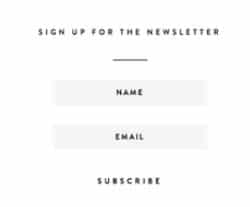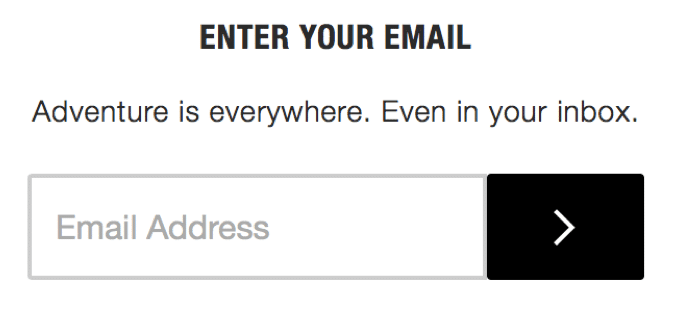5 Creative strategies to build your email list organically
As an email marketer, you may swear by your email software and be proud of your brand image, but your email list is arguably the most important thing you have.
List building is critical, as your subscribers represent your potential. They’re your audience for new content, after all. Collectively, they represent a large portion (perhaps the largest grouping) of your revenue potential.
When you’re looking to generate leads, sales, and brand ambassadors, there’s no better place to look than your email list.
However, many marketers wish they could grow their list. I mean, who doesn’t, really? More subscribers, more consistent growth, more potential—the benefits are obvious. Though there are many growth strategies out there, not all of them are organic in nature.
Organic growth is the type that happens from natural action. You aren’t doing anything outlandish or artificial to grow your list—and, as a result, you achieve the type of growth that translates to real results.
In this post, we’ll discuss five very creative and actionable steps any marketer can take to grow their email list organically.
Organic list-building strategies that deliver real results
Even the most seasoned marketers may find themselves fighting against the numbers sometimes. Despite your best efforts, it’s hard to keep your email list growing no matter how skilled you are in your field.
Your email database shrinks by roughly 22.5% yearly.
Before we start, let’s draw the distinction between organic growth strategies and other alternatives. Organic growth happens naturally, when users are compelled to join your list through sensible steps within a customer journey.
The goal is to reach them where they are, and to deliver an email subscription offer that they can’t resist. This may mean getting creative, but we’ve all heard and tried the typical options.
These include putting a sign-up option on your website and offering a subscription to those who’ve made a purchase (given you’ve collected their email or other contact info). Here are some lesser-discussed strategies for organic mailing list growth:
1. Use subscription offers in blog/article CTAs.
Blogs and/or news articles are a popular content type for keeping your website up-to-date with fresh content. They give your readers a reason to keep clicking, and they provide you with a great way to keep your social channels active.
However, they’re also great for slipping in strategic calls-to-action (CTA). These statements are usually crafted to compel your reader to take a certain step. In most cases, this step could be reading some of your other content. Many marketers will waste no time and offer a sales option right in their CTA.
Blogs and articles are also great places to promote your email list. When a reader finishes a piece of content, they may want more—just not right then. Rather than asking them to click to a new blog and hope they do, you could ask them to sign up for your mailing list.
Source: Cocorrina
This can work in text or graphical form. If your blogging and email voices are consistent, this strategy works even better. This type of CTA is still conducive to sales; it just funnels potential prospects through your email list, strengthening growth rates in the process.
2. Put a sign-up link in your email signature.
Think of all the emails you send out as part of day-to-day communications? This is a great way to get your sign-up link in front of different people.
If you want to promote your list in an indirect manner, consider putting it in your email signature. This area is usually used to promote links anyway, which can include:
-
Your main website
-
A content portfolio
-
Sales pages or product catalogs
An offer to sign-up for your mailing list fits perfectly here as well. The best part is that every email you send out, for any purpose, is transformed into a non-intrusive promotional tool. You’re always promoting your list without having to make it the focal point of the message.
We’ve all heard of the banner ad, or the drop-down ad, to promote a mailing list. Unlike those, the signature saves the offer for the end of the email. Your reader doesn’t feel like the offer is being pushed on them; the passive approach may make them more receptive to it.
If you have the room, you can even offer a brief glimpse into what your reader can expect. In a short sentence, tell them about the frequency you send out content, and any special treats they don’t want to miss out on.
In some cases, you may still take traditional approaches to seeking subscribers. These can include putting out simple ads on your social channels or websites. However, these requests don’t have to be simple just because they’re traditional.
3. Dress up your offers with custom graphics.
Even if you’re creating sticky or sidebar ads that directly promote your mailing list to potential subscribers, you have plenty of options on how to do it. That’s because there are a number of creative design tools you can use to build these offers.
Some marketers may worry about getting too graphically advanced. The fear is that if you have to outsource a lot of your work to your graphic designer, you’re wasting valuable time and thus delaying your offers.
Luckily, there are a number of popular design tools you can use to bring in potential subscribers. Here are a few examples, and tips on how to use them:
-
Canva: This design platform requires no training and no investment to get started. The free-to-use editor is built with plenty of free templates and creative tools. Though there is a paid version, the free version is enough to build emails, ads, graphics, and much more.
-
GIMP: This open-source alternative to Photoshop is another free tool. While it may carry a bit of a learning curve, especially for those who’ve never used similar software, it can do all the basics and more. For building creative offers and graphics, it’s hard to find a better free tool.
-
Pixlr: A popular cloud-based tool, this service does it all. Users can take and share photos, edit images, and even record their screen. For creating great ads that make your offer look better than ever, Pixlr is a great tool to consider.
You don’t always have to rely on flashy graphics with your email subscription offers. Sometimes, taking a closer look at the words you use can help boost organic growth rates.
4. Reexamine the power of your language.
In our earlier example, we showed how a simple email sign-up form at the end of a blog could work wonders. But, look at the example below and note the difference.
Source: Emma
The outdoor company that created this ad used clever word choice to strengthen their offer. It’s topical, brand relevant, and effective. Word choice has been proven to work in multiple instances as a tool for boosting marketing efforts.
Some studies have shown that text is actually superior to images–even in a simple form. The online retailer Fab replaced their cart button, which was a picture of a cart, with the words “Add to Cart.” This simple change increased cart adds by almost 49%.
Stronger language with specifics can also have a big impact. Software company Monthly1K had a headline that read “How to Make Your First Dollar.” After updating to “How to Make a $1,000 a Month Business,” they enjoyed a sales increase of 6.5%.
UK-based debit supplier GoCardless wanted to see if changing one word in their “Request a demo” call to action would make a difference. After changing “request” to “watch” they saw conversions increase by an astonishing 139%.
Better language means better organic list-building success. When you use the right words, you won’t have to dig for subscribers—they’ll come to you naturally.
5. Test different email sign-up offers.
While it’s true that many marketers use testing to gauge the efficiency of campaigns to their existing subscribers, few use it to gain new subscribers. These offers you send out can be subject to A/B testing just like your campaigns.
When emails are tested, through things like metric and website tracking tools, emails can automatically perform better in the future. This is true whether you’re rolling out content to your current list or you’re trying to gain new subscribers. The same practices apply in both cases.
You can segment, experiment with different designs, and track your metrics to give yourself better direction.
There’s also the experimentation process, which could be thought of as a sub-area of testing. Try out different headlines, content layouts, and calls-to-action. The more you experiment, the better your chances of achieving consistent, organic growth area.
Wrap up
Email list building is something that even the most seasoned marketer must do – over and over. It’s a process that requires constant education and experimentation to succeed.
-
Put calls-to-action in blogs and email signatures
-
Try unique wording choices and flashy graphics
-
Use testing and segmentation to extend sign-up offers
After you grow your email list organically, what comes next? Learn what comes after list building by creating a winning strategy to keep your list going strong.
MOST RECENT ARTICLES
Want to engage your audience and grow your brand? Try Emma's robust easy-to-use product today.















